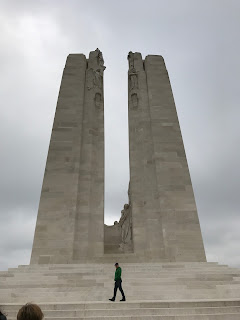The dean had been most impressed with this trip and all that it had accomplished. The group had revealed hidden children in the Netherlands (Maud Dahme and Leo Ullman) in addition to Anne Frank; it had been through som(m)e trenches, and been on Omaha beach at Normandy; it had burrowed among the skeletal remains in the Catacombs; it had traced the early years of Dan Kochavi's life in wartime Paris; it had done all these things, and so much more, and its spirit had remained intact, even buoyant.
The dean determined, therefore, that team leaders Gail Rosenthal and Mike Hayse, who had throughout the tour (though not through Tours) run everything with the precision of a Swiss watch, should be given one last test (which now has included reading a complicated run-on sentence). This test was to put the group through a harrowing (i.e., not Etonian -- English joke) experience, to see whether they would survive as a unit and come through with a plomb and ma chérie (French joke).
This group of 42 happy and expectant souls -- happy because they had accomplished so much, and expectant because every meal had previously been a veritable feast and celebration -- were to be herded into a bare cellar, which, if they were lucky, could just about contain everyone standing straight and to attention. How would they react? What would they do? Would they, like the lunatics performing the Marat/Sade, start rioting and bring destruction to the inSeine asylum? Would they, like the sans culottes of yore and the sans pain et cirque of today, start screaming liberation, liberation, revolution, revolution? How would they respond when the restaurant owner started shouting from the kitchens, "Laissez-les manger du gâteau! Laissez-les manger du gâteau! Let les (words deleted by censor) Américains eat cake"? Only time would tell, the dean thought, and this would surely be an excellent test to determine whether the group deserved to consider itself one of the best Stockton University and Sara and Sam Schoffer Holocaust Resource Center Study Tours ever!
Very quickly everyone sprung into action. Tables and chairs were produced. A unit was sent above ground to forage (and essentially keep the restaurant owner on task). Gail, Mike, Sarah Albertson, Dorene Sellarole, and the indomitable Adam Szczucinski began cooking, ferrying, directing, and all the other action verbs in between, such that some order began to emerge. Meanwhile, with the cellar-dwellers beginning to chant Liberation, Maud decided that she would teach about European Reconciliation. In this case, this meant excising the E and R from liberation, and having the students demand Libation instead, which she duly provided to all of legal age and (now) sounder mind. Donald, the Baron von Scheer, announced that it had always been his life's dream to work in a French restaurant, and so he put on a bally good show as one of our waiters scurrying up and down the stairs. Soon the food was flowing in a bun dance, and fun was being had by all.


The professoriate needed to intervene at this point, so Herr (and his) Doktor Hayse and Madame La Professeur Rosenthal dropped the Mike by giving a wonderful tribute to all of the people on the trip who had made everything, including this last evening, come together so well. Presents and tributes were given to everyone. The students had come up with superlatives for every tour participant, "best this..." and "best that...", all of which were funny and somewhat accurate, besides the one that suggested that the dean "told the best dad jokes." As you can see from the foregoing account, the dean is a firm believer in "just providing the facts" and in serious reportage, so this characterization was a gross miscarriage...well, maybe not!
My thanks to everyone who came on this trip. It was a wonderful, deeply moving learning experience that we will all remember, I am sure, for the rest of our lives. Thanks to Gail, Mike, Adam, Maud, Dan & Jon, Sarah, Dorene, and all the now adopted students (both graduate and undergraduate), who all were so spectacular throughout the trip.


The professoriate needed to intervene at this point, so Herr (and his) Doktor Hayse and Madame La Professeur Rosenthal dropped the Mike by giving a wonderful tribute to all of the people on the trip who had made everything, including this last evening, come together so well. Presents and tributes were given to everyone. The students had come up with superlatives for every tour participant, "best this..." and "best that...", all of which were funny and somewhat accurate, besides the one that suggested that the dean "told the best dad jokes." As you can see from the foregoing account, the dean is a firm believer in "just providing the facts" and in serious reportage, so this characterization was a gross miscarriage...well, maybe not!
My thanks to everyone who came on this trip. It was a wonderful, deeply moving learning experience that we will all remember, I am sure, for the rest of our lives. Thanks to Gail, Mike, Adam, Maud, Dan & Jon, Sarah, Dorene, and all the now adopted students (both graduate and undergraduate), who all were so spectacular throughout the trip.












































